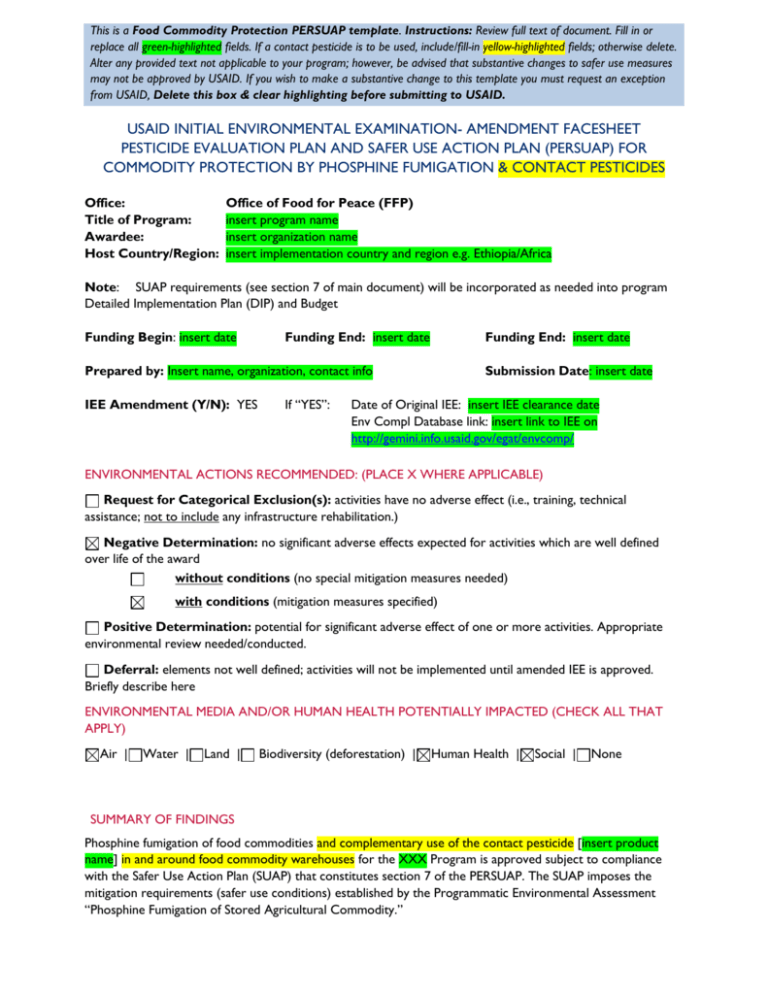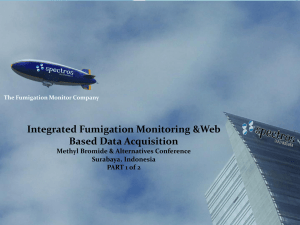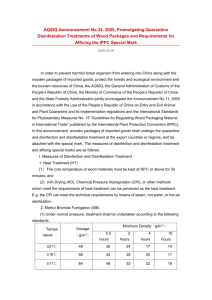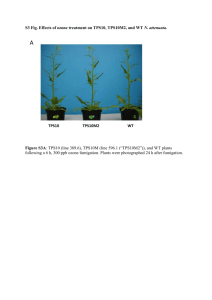Pesticide Evaluation Plan and Safer Use Action Plan
advertisement

This is a Food Commodity Protection PERSUAP template. Instructions: Review full text of document. Fill in or replace all green-highlighted fields. If a contact pesticide is to be used, include/fill-in yellow-highlighted fields; otherwise delete. Alter any provided text not applicable to your program; however, be advised that substantive changes to safer use measures may not be approved by USAID. If you wish to make a substantive change to this template you must request an exception from USAID, Delete this box & clear highlighting before submitting to USAID. USAID INITIAL ENVIRONMENTAL EXAMINATION- AMENDMENT FACESHEET PESTICIDE EVALUATION PLAN AND SAFER USE ACTION PLAN (PERSUAP) FOR COMMODITY PROTECTION BY PHOSPHINE FUMIGATION & CONTACT PESTICIDES Office: Title of Program: Awardee: Host Country/Region: Office of Food for Peace (FFP) insert program name insert organization name insert implementation country and region e.g. Ethiopia/Africa Note: SUAP requirements (see section 7 of main document) will be incorporated as needed into program Detailed Implementation Plan (DIP) and Budget Funding Begin: insert date Funding End: insert date Funding End: insert date Prepared by: Insert name, organization, contact info IEE Amendment (Y/N): YES If “YES”: Submission Date: insert date Date of Original IEE: insert IEE clearance date Env Compl Database link: insert link to IEE on http://gemini.info.usaid.gov/egat/envcomp/ ENVIRONMENTAL ACTIONS RECOMMENDED: (PLACE X WHERE APPLICABLE) Request for Categorical Exclusion(s): activities have no adverse effect (i.e., training, technical assistance; not to include any infrastructure rehabilitation.) Negative Determination: no significant adverse effects expected for activities which are well defined over life of the award without conditions (no special mitigation measures needed) with conditions (mitigation measures specified) Positive Determination: potential for significant adverse effect of one or more activities. Appropriate environmental review needed/conducted. Deferral: elements not well defined; activities will not be implemented until amended IEE is approved. Briefly describe here ENVIRONMENTAL MEDIA AND/OR HUMAN HEALTH POTENTIALLY IMPACTED (CHECK ALL THAT APPLY) Air | Water | Land | Biodiversity (deforestation) | Human Health | Social | None SUMMARY OF FINDINGS Phosphine fumigation of food commodities and complementary use of the contact pesticide [insert product name] in and around food commodity warehouses for the XXX Program is approved subject to compliance with the Safer Use Action Plan (SUAP) that constitutes section 7 of the PERSUAP. The SUAP imposes the mitigation requirements (safer use conditions) established by the Programmatic Environmental Assessment “Phosphine Fumigation of Stored Agricultural Commodity.” APPROVAL OF RECOMMENDED ENVIRONMENTAL ACTION A. Food for Peace Mission or Regional Office, as appropriate: Date Mission Environmental Officer Date Regional Environmental Advisor* Date Regional/Mission Food for Peace Officer* Date Mission Director B. Food for Peace, Washington Date Agreement Officer’s Representative Date Agreement Officer C. Concurrence: Date Erika Clesceri, DCHA Bureau Environmental Officer Accepted: *Clearance is suggested but not mandatory Not Accepted: USAID INITIAL ENVIRONMENTAL EXAMINATION- AMENDMENT Pesticide Evaluation Plan and Safer Use Action Plan (PERSUAP) for Commodity Protection by Phosphine Fumigation & Contact Pesticides USAID FOOD ASSISTANCE PROGRAM DATA Program Name: Insert Awardee: insert organization Country/Region: insert country/region Period of Performance: X years (start date – end date) 1. PURPOSE AND SCOPE OF PERSUAP Upon approval, this Food Commodity Protection PERSUAP, submitted as an amendment to the [insert program name] IEE, will authorize phosphine fumigation of insert program name food commodities. It will also authorize complementary use of the contact pesticide(s) insert product names in and around empty warehouses for these commodities. Fumigation and contact pesticide use is authorized subject to strict safer use conditions. As described herein, use of fumigation and contact pesticide is necessary for successful program implementation. Formally, approval of this PERSUAP will assign a negative determination to phosphine fumigation and use of the contact pesticide [insert product name], subject to the condition that the Safer Use Action Plan provided as Section 6 is fully implemented. This PERSUAP satisfies the requirements of 22 CFR 216.3(b) (USAID Pesticide Procedures) and puts in place the safer use requirements (mitigation measures) established by the USAID Programmatic Environmental Assessment “Phosphine Fumigation of Stored Agricultural Commodity” (Henceforth the “Fumigation PEA.”)1 2. PROGRAM DESCRIPTION Provide a BRIEF (not more than 1 or 2 paragraph description) of the program . 3. COMMODITY PROTECTION NEEDS List the food commodities being managed. Provide general information about the length of time commodities are typically stored in primary, secondary, tertiary warehouses. List known pest problems and succinctly describe consequences of failure to adequately control commodity pests. Do not spend more than 1 or 2 paragraphs on this section. The Fumigation PEA establishes that food commodity protection by fumigation addresses food commodity protection needs that can rarely be completely replaced by other methods. It also establishes that the complementary use of contact pesticide in and around warehouses is usually an integral part of the fumigation process to kill insects escaping fumigation and prevent re-infestation of the commodity. 1 Approved (insert date). Insert USAID Environmental Compliance Database link, when uploaded. 4. PROPOSED PESTICIDE(S). This PERSUAP requests approval to use aluminum phosphide as an indoor fumigant at storage facilities for the following commodities: [insert commodity names]. Use is requested of both pellet and tablet formulations with 55-57% active ingredient. This PERSUAP also requests approval to use the contact pesticide insert product name as a complement to fumigation in and around food commodity warehouses. 5. FACTOR ANALYSIS PER 22 CFR 216.3(B)(1)(I)(A THROUGH L) This section provides the 12-factor analysis required by 22 CFR 216.3(b) to allow USAID to make a determination as to whether to permit use of a proposed pesticide and to establish appropriate safer use conditions. Separate Factor Analyses are provided for (1) Aluminum Phosphide and (2) insert name of contact pesticide. FACTOR ANALYSIS FOR ALUMINUM PHOSPHIDE ANALYSIS FACTOR ANALYSIS (a) USEPA registration status of the proposed pesticide. Aluminum phosphide is an inorganic phosphide registered in the U.S under CAS Number 20859-73-8 with U.S. EPA PC Code 066501. Aluminum phosphide is a Restricted Use Pesticide (RUP) so in the US may be purchased and used only by certified applicators. It is in EPA’s toxicity Class I, and products containing it must bear the signal word DANGER. In contact with water, it produces a toxic gas hydrogen phosphide. Aluminum phosphide is widely used for fumigation of food commodities and structures. Host country registration status (b) Basis for selection of the pesticide Provide analogous host country registration information and any restrictions established by this registration The selection of aluminum phosphide is based on: efficacy against pests of stored grains, low cost, availability in country, and registration in country. If used in accordance with safeguards, aluminum phosphide is not expected to have adverse environmental impacts; this is also a factor in its selection. Efficacy and the effectiveness of use safeguards have already been assessed extensively in the Fumigation PEA and thus are not addressed further here. The selection was also based on the availability of a qualified professional service provider for phosphine fumigation. (c) Extent to which the proposed pesticide use is, or could be, part of an IPM program The Safer Use Action Plan requires compliance with Fumigation PEA Annex T-6 “IPM PRACTICES & INSPECTION CHECKLIST FOR COMMODITIES AND WAREHOUSES.” This is a version of the checklist contained in the Food for Peace Commodity Reference Guide modified to implement key good-housekeeping based Integrated Pest Management (IPM) practices that are essential complements to fumigation, including daily sanitation of the warehouse; clearing warehouse surroundings of weeds on a weekly basis; daily inspections for pests; and strictly adhering to the first in first out (FIFO) rule to minimize the storage time of the commodities in the warehouse. (list any additional IPM food commodity protection practices to which the program is committing.) (d) Proposed method or methods of application, including the availability of application and safety equipment Aluminum phosphide will be used for indoor fumigation of warehoused food commodities in sheeted stacks only. Via the Fumigation Management Plan, the SUAP requires that fumigation follow acceptable technical practices specified in Annex T-7 of the Fumigation PEA. These include, among others, use of appropriate personal protection equipment, including respirators, maintenance of an exclusion zone that only fumigation personnel can enter for duration of the fumigation (7-10 days or more), and phosphine gas monitoring for efficacy and hazard. Note if the program’s fumigation services provider will provide PPE and monitoring equipment, or if the program will do so. (e) Any acute and long-term toxicological hazards, either human or environmental, associated with the proposed use, and measures available to minimize such hazards. The potential toxicological effects of aluminum phosphide are well covered by EXTOXNET, and Extension Toxicology Network.* The Fumigation PEA includes details of acute human health exposure and potential impacts to fumigators, other on-site workers, visitors, nearby residents and beneficiaries. In summary: The main routes of exposure to aluminum phosphide are through inadvertent ingestion or inhalation during fumigation of the highly toxic gas. Symptoms of mild to moderate acute aluminum phosphide toxicity include nausea, abdominal pains, tightness in chest, excitement, restlessness, agitation and chills. Symptoms of more severe toxicity include diarrhea, cyanosis, difficulty breathing, pulmonary edema, respiratory failure, tachycardia and hypotension, dizziness and or death. The available evidence for reproductive effects in animals suggests that they are not likely in humans under normal conditions. No evidence is available to support teratogenic effects in humans or to support the ability of aluminum phosphide to cause mutations or increase mutation rates. There is no evidence of aluminum phosphide having a negative impact on soil or ground water. It breaks down spontaneously in the presence of water to form a gaseous product, thus is non-persistent and non-mobile in soil and poses no risk to groundwater. For the same reasons, it is unlikely that aluminum phosphide or phosphine will contaminate surface waters. The USEPA has determined that uses of aluminum phosphide will not generally cause unreasonable adverse effects to humans or the environment if used in accordance with the approved use directions and revised precautionary statements prescribed by the registration standard. Requirements for acute toxicity data have been waived because of the well-known extreme inhalation toxicity of phosphine gas, which it generates. Accordingly, aluminum phosphide has been placed in toxicity category I, the highest toxicity category. Tolerances have been established for raw agricultural commodities at a level of 0.1 ppm (40 CFR 180.225); processed foods 0.01 ppm (21 CFR 193.20); and animal feeds 0.1 ppm (40 CFR 561.40). Finished food and feed must be held and aerated 48 hours prior to being offered to the consumer. Via the Fumigation Management Plan, the SUAP requires that fumigation follow acceptable technical practices specified in Annex T-7 of the Fumigation PEA. These include, among others, use of appropriate personal protection equipment, including respirators, maintenance of an exclusion zone that only fumigation personnel can enter for duration of the fumigation (7-10 days or more), and phosphine gas monitoring for efficacy and hazard. *http://pmep.cce.cornell.edu/profiles/extoxnet/24d-captan/aluminum-phosphide-ext.html (f) Effectiveness of the requested pesticide for the proposed use. Aluminum Phosphide is registered by US EPA as stored grain pesticide. It is considered the most effective method of controlling stored commodity pests, especially when used in an IPM framework, as described above in (c). In-country experience is that this fumigant is very effective in killing the intended targets noted in section 3 within the prescribed seven to ten day fumigation time. Describe any resistance reported or known to you. If none, “We are not aware of any instances of resistance to aluminum phosphide by the intended target pests.” (g) Compatibility of the proposed pesticide use with target and nontarget ecosystems. As an indoor fumigant, aluminum phosphide presents risks to fumigators and those working or living nearby, but there is not a “target ecosystem” of concern. (h) The conditions under which the pesticide is to be used, including climate, flora, fauna, geography, hydrology, and soils As noted, aluminum phosphide will be used solely for indoor fumigation of warehoused food commodities: Briefly describe the warehouse(s) in which fumigation will occur, their setting, proximity to other structures & their uses. Indoor use, non-persistence and non-mobility in soil, negligible potential to contaminate surface waters, and a short half-life in air of ~5 hrs (daylight) mean that aluminum phosphide has essentially no interaction with or impact on non-target ecosystems. Indoor use, non-persistence and non-mobility in soil, and negligible potential to contaminate surface waters (see “factor e,” analysis, above) mean that geography, hydrology and soils have negligible bearing on safety, efficacy or appropriateness. Climate is relevant only in that extremely dry air can retard formation of phosphine gas from phosphine tablets, requiring appropriate adjustments to fumigation protocols. This is/is not anticipated to be an issue in XXX, where typical indoor temperatures will range between X⁰C & Y⁰C and humidity between X and Y%.. (i) The availability and effectiveness of other pesticides or nonchemical control methods The fumigation PEA assesses the effectiveness and availability of non-chemical control methods. As noted, the Safer Use Action Plan requires good housekeeping IPM measures such as daily sanitation of the warehouse and weekly clearing of warehouse surroundings of weeds; daily inspections for pests and strictly adhering to the first in first out (FIFO) rule to minimize the storage time of the commodities in the warehouse. The complementary contact pesticide [insert name] will be used to kill insects escaping fumigation and prevent re-infestation of the commodity. As documented by the PEA, such complementary use of contact pesticide in and around warehouses is usually an integral part of the fumigation process to (j) The requesting country's ability to regulate or control the distribution, storage, use and disposal of the requested pesticide Host country registration status is documented under Factor A, above. (k) The provisions made for training of users and applicators Regardless of host country licensing, describe the training standard of fumigator service provider personnel. (l) The provisions made for monitoring the use and effectiveness of the pesticide The SUAP requires a Fumigation Management Plan that serves as detailed log of each fumigation episode. The FMP requires efficacy monitoring of phosphine gas concentrations to better assure that required concentrations are attained for the required period. This is critical to the efficacy of the individual fumigation and to preventing emergence of resistance. Monitoring of commodities for infestation is a routine element of program management; quick re-infestations are the primary indicator that fumigation is ineffective. Note whether phosphine fumigation requires a license in your host country, and the requirements for obtaining such a license. Note whether such licensing is meaningfully enforced. FACTOR ANALYSIS FOR [INSERT NAME OF CONTACT PESTICIDE] ANALYSIS ANALYSIS FACTOR (a) USEPA registration status of the proposed pesticide. Provide EPA registration status. Note that the pesticide must be registered for the same or similar uses by US EPA. Provide analogous host country registration information and any restrictions established by this registration. Note that the pesticide must be registered in the host country AND by US EPA. Host country registration status (b) Basis for selection of the pesticide Availability, cost, efficacy, and relatively low toxicity to humans and non-target organisms should be key selection factors/ (c) Extent to which the proposed pesticide use is, or could be, part of an IPM program The Safer Use Action Plan requires compliance with Fumigation PEA Annex T-6 “IPM PRACTICES & INSPECTION CHECKLIST FOR COMMODITIES AND WAREHOUSES.” This is a version of the checklist contained in the Food for Peace Commodity Reference Guide modified to implement key good-housekeeping based Integrated Pest Management (IPM) practices that are essential complements to fumigation, including daily sanitation of the warehouse; clearing warehouse surroundings of weeds on a weekly basis; daily inspections for pests; and strictly adhering to the first in first out (FIFO) rule to minimize the storage time of the commodities in the warehouse. (list any additional IPM food commodity protection practices to which the program is committing. ) (d) Proposed method or methods of application, including the availability of application and safety equipment (e) Any acute and long-term toxicological hazards, either human or environmental, associated with the proposed use, and measures available to minimize such hazards. (f) Effectiveness of the requested pesticide for the proposed use. (g) Compatibility of the proposed pesticide use with target and nontarget ecosystems. (h) The conditions under which the pesticide is to be used, including climate, flora, fauna, geography, hydrology, and soils (i) The availability and effectiveness of other pesticides or nonchemical control methods Describe any resistance reported or known to you. This pesticide will be used solely for spraying the interior and immediate perimeter of empty warehouses. The settings for these warehouses are described under the factor analysis for aluminum phosphide, above. Follow with additional relevant information The fumigation PEA assesses the effectiveness and availability of non-chemical control methods. As noted, the Safer Use Action Plan requires good housekeeping IPM measures such as daily sanitation of the warehouse and weekly clearing of warehouse surroundings of weeds; daily inspections for pests and strictly adhering to the first in first out (FIFO) rule to minimize the storage time of the commodities in the warehouse. The complementary contact pesticide [insert name] will be used to kill insects escaping fumigation and prevent re-infestation of the commodity. As documented by the PEA, such complementary use of contact pesticide in and around warehouses is usually an integral part of the fumigation process to (j) The requesting country's ability to regulate or control the distribution, storage, use and disposal of the requested pesticide (k) The provisions made for training of users and applicators (l) The provisions made for monitoring the use and effectiveness of the pesticide Host country registration status is documented under Factor A, above. XXX does/does not have t The SUAP requires, via the 6. FINDINGS In consequence of the analysis above, and the referenced Fumigation PEA, warehouse food commodity phosphine fumigation for program name food commodities and use of the complementary contact pesticides [insert name(s)] is [are] recommended for approval subject to full compliance with and implementation of the Safer Use Action Plan (SUAP) that constitutes the following section. The SUAP imposes on program name phosphine fumigation and complementary contact pesticide use the mitigation measures established by the Fumigation PEA. In summary, these conditions are: Implementation of good-housekeeping IPM Measures that are essential complements to fumigation per Fumigation Annex T-5 Implementation of a Fumigation Management Plan for each fumigation event substantively conforming to the plan provided as Annex T-3 to the Fumigation PEA, EXCEPT as noted in the SUAP. Complementary Use of Contact Pesticides will (1) be limited to the pesticide(s) authorized by this PERSUAP and substantively conform to contact pesticide best practices as set out in Fumigation PEA Annex T-6, EXCEPT as noted in the SUAP. Storage and Transport of Aluminum Phosphide and Contact Pesticides, if under program control, will substantively conform to contact pesticide best practices as set out in Fumigation PEA Annex T-6, EXCEPT for changes specified below and/or subsequently approved by the DCHA BEO. Food and feed commodities that have been fumigated with phosphine must be held and aerated for 48 hours prior to distribution. Monitoring and Corrective Actions. Program will actively monitor compliance with above-listed conditions and undertake corrective actions as needed. Formally, upon approval of this PERSUAP, the program name IEE is amended so that phosphine fumigation activities receive a 22 CFR 216 negative determination subject to the condition of compliance with the SUAP provided below. 7. SAFER USE ACTION PLAN (SUAP) The SUAP is provided as a mandatory “safer use action plan and compliance tracker” form. This form both enumerates safer use requirements and sets out how program name will implement these requirements. Additionally, it serves as a compliance tracking and reporting tool, and will be submitted annually as an annex to the Environmental Status Report. Note: with respect to fumigation, the Safer Use Action Plan from satisfies the requirement for an environmental mitigation and monitoring plan (EMMP). The program EMMP should simply incorporate the SUAP by reference. [INSERT USAID FOOD ASSISTANCE PROGRAM NAME] FUMIGATION SAFER USE ACTION PLAN & COMPLIANCE TRACKER This is an integral part of the PERSUAP and must be submitted annually with Environmental Status Report (ESR). PROGRAM & CONTACT INFORMATION DATE OF ANNUAL REPORTING SUBMISSION: Awardee Annual Update #1 Program Name Annual Update #2 Fumigation Compliance Lead Name and title Annual Update #3 Contact Information Email & telephone Annual Update #4 FUMIGATION LOG (record all fumigation events since the last annual update) Dates Location (Town or City) P=Primary, S=Secondary, T=Tertiary Warehouse Type P* S* Commodity & Quantity Fumigated T* Key Exceptions/Incidents per FMP log. REQUIRED COMPLIANCE MEASURES ACTIONS PLANNED TO ACHIEVE & MAINTAIN COMPLIANCE (w/ deadlines & responsible party) Good Housekeeping IPM Measures. Fully implement the daily/weekly warehouse and commodities inspection checklist (Fumigation PEA Annex T-5) and take maintenance/corrective actions specified. NOTE: compliance with this checklist implements a set of IPM measures that are essential complements to fumigation. Fumigation Management Plan. A fumigation management plan (FMP) will be implemented for each fumigation event. The FMP and the actual fumigation process will substantively conform to the plan provided as Annex T-3 to the Fumigation PEA, EXCEPT for changes specified below and/ or subsequently approved by the DCHA BEO. Each completed plan shall be retained for 2 years. Complementary Use of Contact Pesticides will (1) be limited to the pesticide(s) authorized by this PERSUAP and substantively conform to contact pesticide best practices as set out in Fumigation PEA Annex T-6, EXCEPT for changes specified below and/or subsequently approved by the DCHA BEO. Storage and Transport of Aluminum Phosphide and Contact Pesticides, if (insert extra rows if needed (insert extra rows if needed (insert extra rows if needed STATUS OF COMPLIANCE ACTIONS (for instance text) under program control, substantively conform to contact pesticide best practices as set out in Fumigation PEA Annex T-6, EXCEPT for changes specified below and/or subsequently approved by the DCHA BEO. (insert extra rows if needed When Using a 3rd-Party Fumigation Service Provider: The provided model RFQ and contract (or substantive equivalent) will be used to procure fumigation services and proposals/quotes will be evaluated based on ability to comply with specified safer use practices. Monitoring and Corrective Action. Program will actively monitor compliance with above-listed conditions and undertake corrective actions as needed. (insert extra rows if needed (insert extra rows if needed) REQUESTED EXCEPTIONS AND CHANGES TO SPECIFIED MANAGEMENT PRACTICES Enter here specific requested exceptions or changes to fumigation practices as per template Fumigation Management Plan provided by the Fumigation PEA Annex T3 or storage, transport, and contact pesticide practices per Annex T-6. Reference by number & provide justification in each case. Alternately, a strike-through edit of the FMP may be submitted. (add lines as necessary. . .)






